| Table of Content 1. introduction 2. Kanha in Monsoon 3. Scenic Beauty 4. Temperature Shifts 5. Flora & Fauna 6. Wildlife 7. Conclusion |
Curious about how Kanha National Park looks during monsoon?
It’s SURREAL!
Nestled in the heart of Madhya Pradesh, Kanha National Park is renowned for its rich biodiversity and stunning natural beauty. Spanning over 940 square kilometres, this sprawling sanctuary is home to a diverse range of wildlife, including tigers, leopards, sloth bears, and over 300 species of birds attracting visitors, wildlife enthusiasts, photographers, naturalists from around the world.
Kanha National Park is known for its diverse climate as well, which is primarily tropical in nature. The summer season can be exceptionally hot, with temperatures reaching a blistering 43 degrees Celsius.
However once the monsoon strikes between June and September, the park is transformed into a verdant haven as the rains revitalize the surroundings while offering a refreshing and cooler environment to the park’s inhabitants.
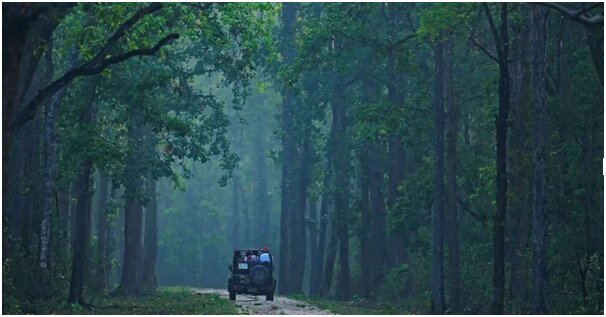
Lush Green Kahna during the monsoons (Referred from Google)
Although the park is closed and safari comes to a halt due to unfavourable climate conditions, let us take you on a virtual trip to Kanha’s lush and scenic monsoon splendour through our blog.
Kanha in Monsoon
Arrival of monsoon around mid-June brings breath-taking transformation of Kanha National Park, shifting the landscapes from a dry, brown to vibrant shades of green. One can feel the air becoming crisp and fresh, while the park gets filled with the sounds of raindrops and the calls of various wildlife.
With an average rainfall of 1800 mm each year, Kanha comes to life, replenishing its lakes, waterholes, streams, and the Banjar River that meanders through the park. These water sources develop into thriving centres that draw a wide variety of species to their verdant borders.
Herds of deer, stately Indian bison (gaur), and even elusive tigers are frequently seen at these waterholes during this enchanted season, satisfying their thirst and basking in the richness of nature’s bounty.
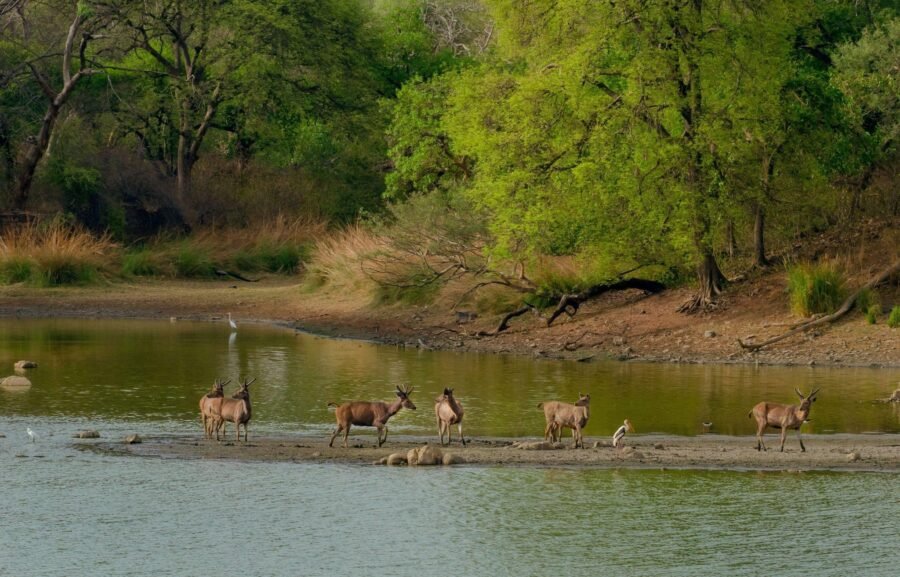
A herd of deer quenching its thirst at the lake in Kanha (Referred from Google)
Scenic Beauty
As the monsoon showers bless the land, every corner of Kanha beckons with its serene beauty.
Kanha during monsoon undergoes a mesmerizing transformation, unveiling its hidden scenic wonders. Lush greenery blankets the landscape, painting a picturesque scene that captivates the soul.
The rain-kissed forests come alive with a vibrant symphony of colours and fragrances. The meandering streams and glistening water bodies brim with life, reflecting the verdant surroundings like mirrors of nature’s artistry.
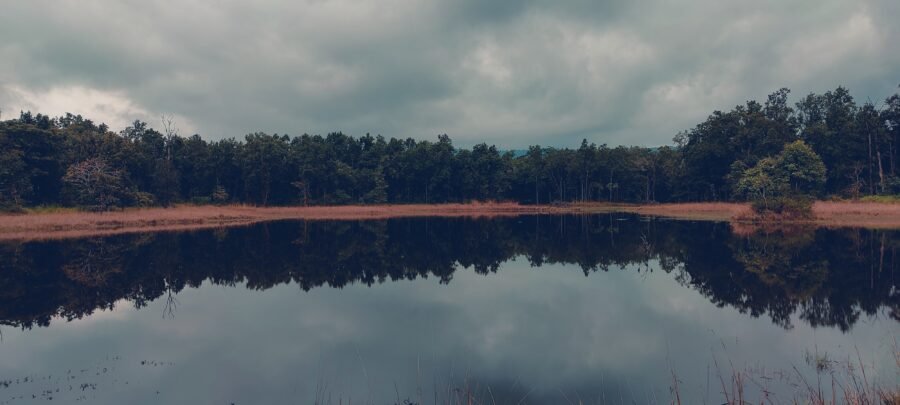
Kanha’s breath-taking landscapes mirrored in its tranquil lake
Towering trees adorned with fresh foliage provide a sanctuary for myriad bird species, their melodies echoing through the misty air. Amidst the emerald hues, glimpses of majestic wildlife emerge, adding an aura of mystique to the breath-taking panorama.
Temperature Shifts
In Kanha National Park, the climate boasts a varied and predominantly tropical environment.
During the monsoon, the day temperatures in Kanha range from 22°C to 30°C (72°F to 86°F). The cooler night-time temperatures ranging from 22°C to 25°C (72°F to 77°F), along with the fresh, rain-soaked air, make the nights cold and comfortable for the inhabitants.
Kanha also experiences a considerable rise in humidity levels during this time of the year, often going as high as upto 80%. The thick air filled with moisture contributes to the lush growth of vegetation but can also make the atmosphere feel quite muggy.
Flora & Fauna
Monsoons are one of the best seasons for forests as diverse flora flourishes under the nourishing downpour.
During this season, the flora of the Park thrives and transforms into a lush, vibrant landscapes as the heavy rains rejuvenate the park’s vegetation, resulting in dense and green forests of Sal and bamboo, providing a lush canopy overhead.
The meadows are covered with tall, verdant grasses. Various wildflowers bloom, adding bursts of colour throughout the park.
Ponds, lakes, and streams fill up, supporting aquatic plants and creating a diverse habitat.
During monsoon Kanha’s fauna is also at its most active. Birds, in particular, rejoice in the refreshing showers from the sky.
The park is home to over 300 bird species, and the monsoon season sees an influx of migratory birds. Birds species that are easy spotted in these days are the crested serpent eagle, the lesser adjutant stork, and the green pigeon. A variety of insects, including butterflies and dragonflies, become more active, contributing to the park’s rich tapestry of life.
Wildlife
Trees and shrubs sprout new leaves, creating a rich, green environment, making it a stunning and fertile sanctuary for wildlife. The lush vegetation and increased water sources provides ample food for herbivores, which in turn attracts predators like tigers and leopards.
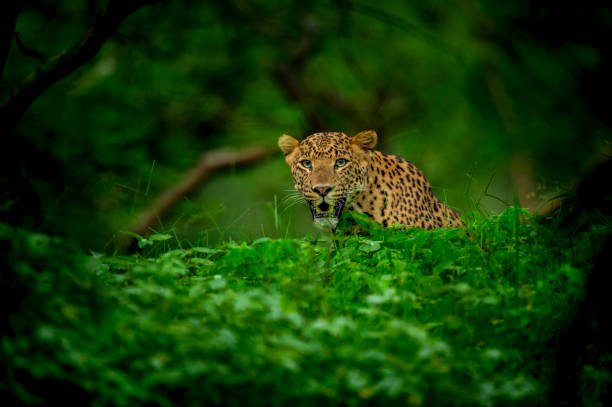
A leopard basking in the lush green grounds of Kanha in monsoon (Referred from Google)
The monsoon season brings out the herds of Gaur, in to the grasslands where these massive herbivores can be seen grazing.
Kanha National Park is home to several species of deer, including the spotted deer (chital) and the majestic Sambar deer. These graceful animals can be spotted frolicking in the meadows or seeking shelter from rain under the canopy of trees.
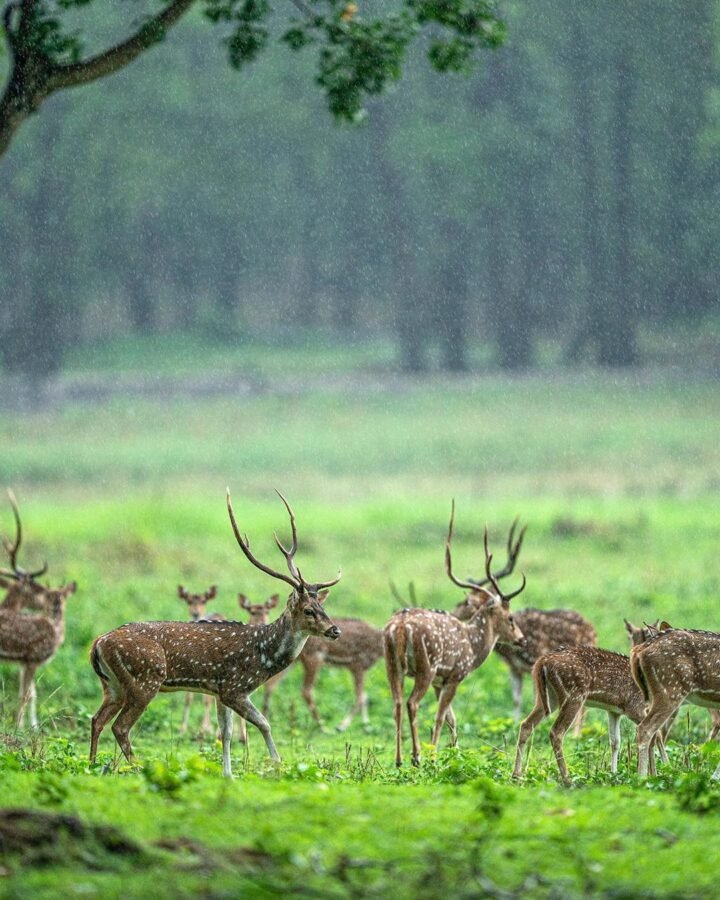
Herd of Spotted Deer enjoying the drizzle (Referred from Google)
The habitat also sees a major boost in the insect and arachnid activity and myriad caterpillars are seen gobbling up the fresh, green leaves and spiders of different kinds are waiting to capture an unsuspecting insect for food. The increased moisture and water-bodies unleash the reptiles and amphibians, including frogs, toads, and snakes, contributing to the park’s dynamic ecosystem.
Conclusion
The monsoon season transforms Kanha National Park into a lush, green paradise, revitalizing its flora and fauna and replenishing water bodies, including the Banjar River. The tranquil silence of the forest and the gentle rustle of leaves create a symphony of nature’s grandeur, making Kanha’s monsoon beauty unparalleled. And although the park is closed to visitors during this time, it thrives with vibrant vegetation and active wildlife, enticing us to visit when it reopens for safari in October.



